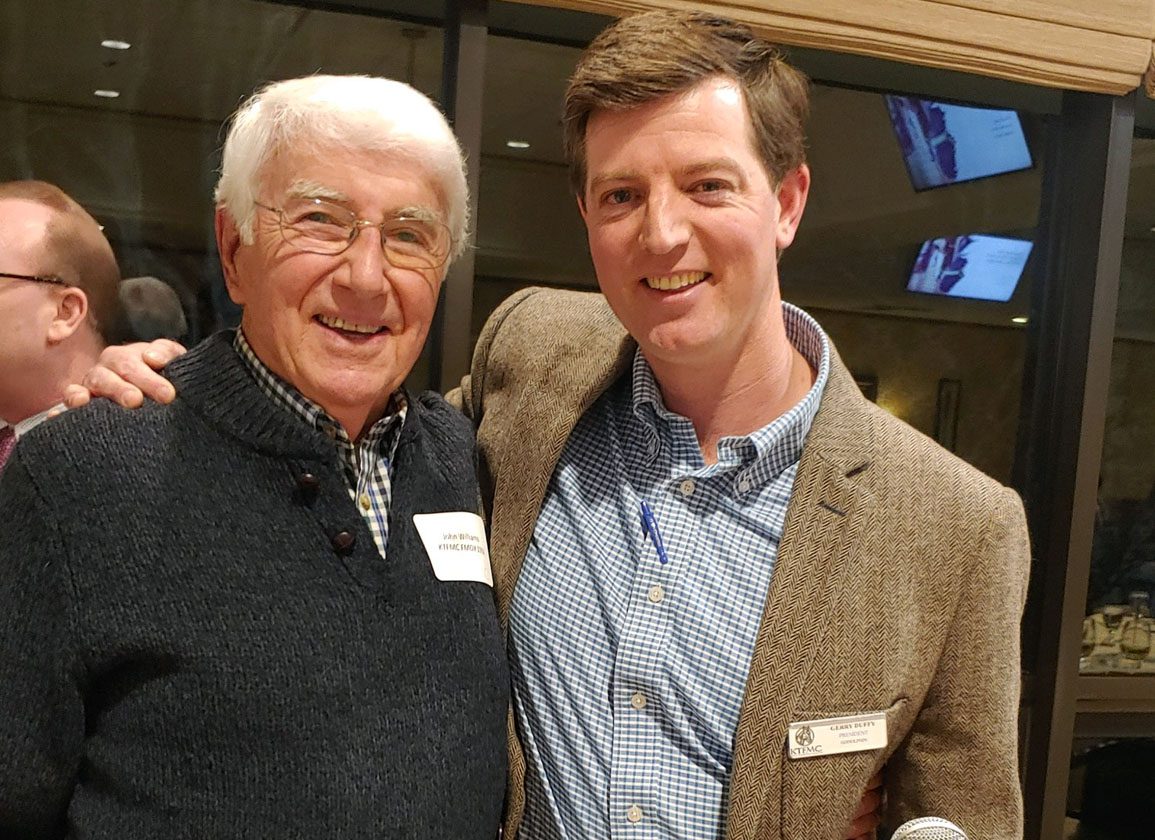by Sara Gordon and Katie Petrunyak
LEXINGTON, KY-The Kentucky Thoroughbred Farm Managers Club (KTFMC) held its first meeting of the year on Tuesday at Keeneland. The event was conducted jointly with the Kentucky Association of Equine Practitioners (KAEP) and the over 200 in attendance represented both organizations. Members of the Godolphin Flying Start and Kentucky Equine Management Internship programs were also on hand.
Recent changes and trends in the equine veterinary field were a focal point of the evening, along with topics including equine litigation and liability, navigating equine veterinary practice changes and the equine veterinarian shortage.
KTFMC President Gerry Duffy said their board brought up the issue of the equine veterinary shortage as a potential topic for their monthly meeting and from there, they partnered with the KAEP knowing that the subject would be relevant to both organizations.
“We know that the vet-farm manager relationship is so important and we have been hearing statistics about how they’re struggling to get equine practitioners and of the ones they get, there’s a high degree of partition,” Duffy explained. “We thought it would be a good topic to discuss at the meeting and when we got talking to the KAEP, they were having a meeting focused on equine veterinary litigation and liability so we thought, why not bring the two together?”
A ‘Q and A’ session on the Horseracing Integrity and Safety Act (HISA) was also conducted with HISA’s Director of Equine Safety and Welfare Dr. Jennifer Durenberger and HISA Representative Marc Guilfoil, bringing forth a host of questions on the new responsibilities that those overseeing horses outside of the racetrack would take on if and when HISA comes into authority.
Evolving Landscape of Equine Insurance Coverage
Equine attorney Mike Casey of Casey Bailey & Maines, PLLC, based in Lexington, was the first speaker to the podium, leading a discussion on the evolving landscape of equine insurance coverage and the particulars of filing a claim under those policies.
Casey emphasized the importance of the relationship between vets and farm managers, particularly when it comes to how the vets document interactions with their patients and handle subsequent care when called out to the farms. This is all information that is not only necessary for those directly connected to the horse, but also required when it comes to instances of filing a claim, such as equine mortality, with an insurance agency.
Common issues that arise involve how often the vet visits the patient, varying whether the visits are routine or for a specific health issue, which correlates with the problematic pressure to prescribe medication without examining the patient first.
“It is critically important to make sure when you’re administering medications that you have that temporal visit with the horse,” said Casey.
He also touched on the growing issue of using medication on a horse that it was not originally prescribed to.
“I probably see that more today, in the last two or three years, than the last 10 years before.”
All of these issues were weighed against what the insurance company would be looking for when handling a claim, which always leads back to the importance of maintaining precise, updated documentation. Medical records must include enough detail that anyone checking on the horse should be able to know exactly what their health status is, what treatments they have received in the past and how things should be handled for that particular patient going forward.
“Farm managers need to call the vet and make sure they see the horse the next day. It’ll hopefully avoid a catastrophic outcome and it is in compliance with regulations that we know will have heightened scrutiny as we go to HISA, or as KAEP redrafts regulations,” said Casey.
When dealing with mortality insurance claims, farm managers should take the time to read through the entire policy in order to understand what is expected of them when dealing with the insurance company. In that same vein, all communication with the designated representative of the insurance company should also be documented, to avoid any issues when filing a claim down the road.
Casey explained why understanding any negating factors, such as instances of failure to provide improper care, is crucial. His example touched on use of a medication on a horse that it was not prescribed to, which could fall under the realm of an “intentional act” of improper care. In most cases, “proper care” is defined after the fact.
“We want to be able to connect the prescription to the horse, to the vet’s visit, to prevent application of the unauthorized medication claim,” he said.
Communication and proper documentation are the key points when it comes to vets and farm managers abiding by regulations, maintaining the proper care for the horses in their charge, and ensuring that in the case of any insurance claims filed, everything is presented properly to guarantee a seamless process.
According to Casey, there is no such thing as too much communication, using the example of emailing the insurance agency a summary of the vet’s visit for annual vaccinations to prove his point. Farm managers must also understand that a vet isn’t going to report directly to the insurance agency in the case of a claim, so they must maintain their own day-to-day records as well.
“We’ve got to establish a dialogue for this industry, [when it comes to] what is reasonable, proper and the routine method of doing business. It is important that insurers play a role in this,” said Casey. “It’s too easy to use the sins of others in the industry to say, ‘That’s why we have a heightened medication claim.’”
As he concluded his presentation, Casey reiterated the importance of ensuring all treatment decisions and medications are being administered based on the physical examination of that horse.
Equine Practitioners Discuss Vet Shortage
While most meeting attendees were aware of the equine veterinary shortage, the statistics shared by Hagyard’s Dr. Luke Fallon were staggering.
Fallon said that according to a recent survey conducted by the American Association of Equine Practitioners, by 2030, equine medicine will need over 5,000 veterinarians to meet the growth in demand. Currently there are approximately 3,650 practicing equine veterinarians in America.
Additionally, of the 3,300 veterinary graduates each year from U.S. schools, only 1.3% will enter the equine profession directly. While 4.5% will enter an internship program, 50% will leave the equine profession within five years.
“If you do the math, the shortage of equine veterinarians is already here,” Fallon said. “Why are equine vets leaving the profession? Burnout is one of the key factors. It is a demanding job with long hours and low starting salaries compared to small animal jobs, which often include a signing bonus as high as $200,000 for new graduates.”
Fallon explained that many young students enter veterinary school with the dream of becoming an equine practitioner, but turn to small animal medicine because it is a more logical step financially. He said that equine veterinarians usually start at between a third and half of the initial salary of a small animal veterinarian.
Fellow Hagyard veterinarian Rhonda Rathgeber joined the conversation to discuss a few of the new initiatives Hagyard is working on to encourage veterinary students to consider a career in the equine industry.
Hagyard has enhanced their recruitment efforts by hosting student weekends to show how their facility operates and share details about their externship program. Although the initiative has been hurt in recent years due to the pandemic, it has led to increased numbers in their externship program.
“We are up to 150 externs this season, so if your veterinarian has an extern or a student with them, please be patient,” Rathgeber advised. “We’ve done a lot of work to get them to come and see what it’s really like.”
Hagyard has also increased their outreach through college visits. Last year, they visited a third of the veterinary colleges in the country. Additional recruitment efforts include a podcast, their participation in the annual Opportunities in Equine Practice Seminar hosted by Rood & Riddle Equine Hospital and also hosting their own undergraduate seminars for pre-vet students.
Jim Heird, PhD, rounded out the session to discuss one promising step toward overcoming the shortage. Heird is a member of the advisory council for Lincoln Memorial University’s Equine Veterinary Education Program (EVEP), which provides an accelerated, six-and-a-half year path to a Doctor of Veterinary Medicine degree. Students go through the undergraduate program at LMU and as long as they maintain a 3.35 GPA, they are automatically accepted into the school’s veterinary program.
The EVEP places an emphasis on their students developing hands-on horsemanship skills. Students will work on-farm summer internships during their undergraduate years and then will intern at clinics during their summers in the veterinary program.
Heird said that LMU produces more equine veterinarians than any other school in the country.
“When I think about my career, I don’t know of anything that I’ve done that has as much impact on the future of this industry than this program could have,” he said. “That’s why I’m so passionate about it.”

HISA’s Director of Equine Safety and Welfare Dr. Jennifer Durenberger and HISA Representative Marc Guilfoil
Concerns for Consignors and Managers Brought to Light During HISA Q and A
The evening concluded with a focus on HISA, where attendees were given the opportunity to ask Durenberger and Guilfoil questions. Pertinent to those in attendance, many questions focused on the regulations for those dealing with horses covered under HISA, outside of the track, such as consignors at the sales or farm managers handling lay-ups at the farm.
Though HISA has already released handbooks for racetracks, racetrack maintenance, regulatory veterinarians, attending veterinarians and trainers, Durenberger did say that handbooks for groups such as farm managers, consignors and off-track vets were in the works.
In the meantime, she emphasized that it would be the responsible party’s job to update any records related to a “covered horse” in the HISA online portal, as those records would not be required until the horse returned to the racetrack. In those cases, the responsible party would more than likely be the trainer.
Further concern was expressed for clarifying who the responsible party would be, depending on different situations when the horse is not at the track, and specifying the time requirements for submitting any updates to a horse’s medical record. Durenberger assured those asking these questions that further details would be provided, in hopes of clearing up any misunderstanding.
For almost 100 years, the KTFMC has helped build community and camaraderie among farm managers while also working to find solutions for challenges that these managers face. Their current officers are President Gerry Duffy (Godolphin), Vice President Adrian Wallace (Coolmore), Treasurer Charles Hynes (Coolmore), Secretary Molly Harris (Shawhan Place) and Sergeant-At-Arms B.G. “Scooter” Hughes (Hughes Racing Stable). The club boasts over 500 members and hosts a number of annual charitable fundraisers including a golf scramble, a trail ride, a 5k run, and more. For more information on the KTFMC or to apply for membership, visit www.ktfmc.org or email info@ktfmc.org
The post KTFMC Meeting: Equine Veterinary Changes, Implications for Farm Managers appeared first on TDN | Thoroughbred Daily News | Horse Racing News, Results and Video | Thoroughbred Breeding and Auctions.







